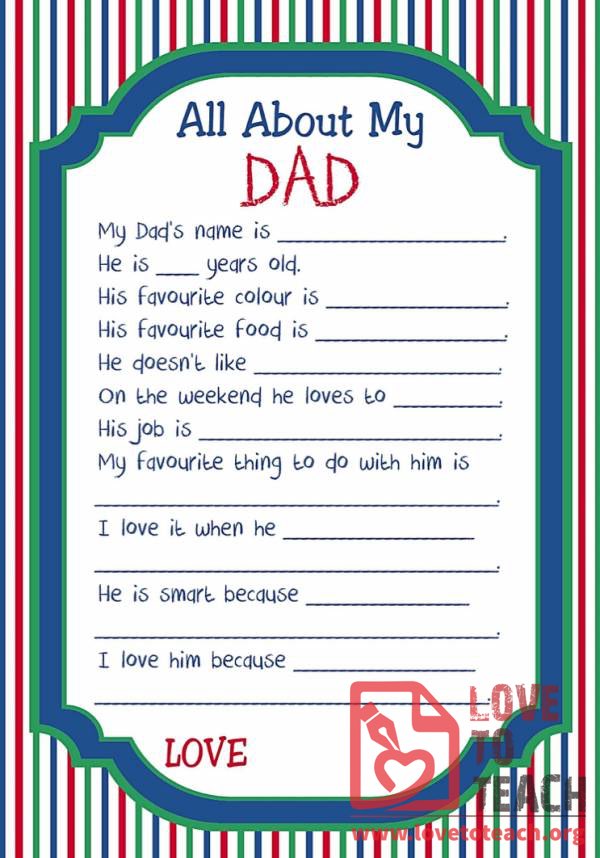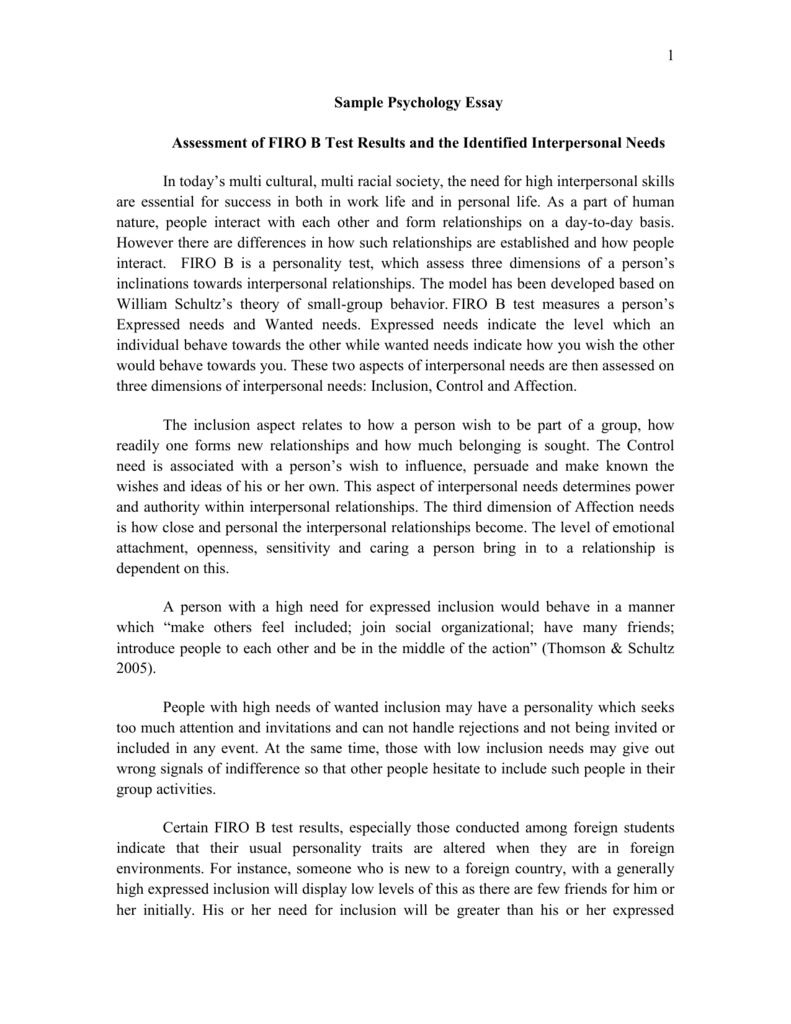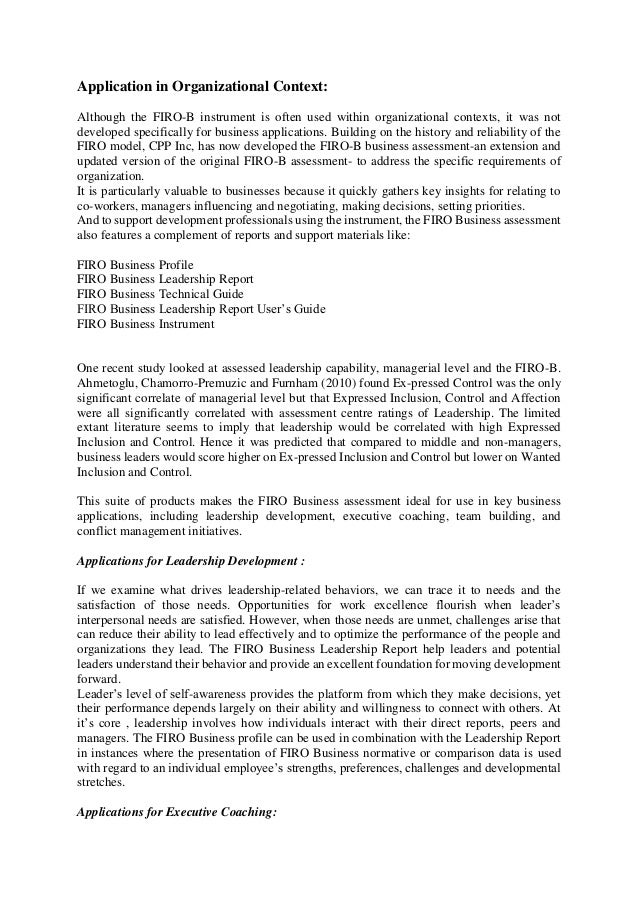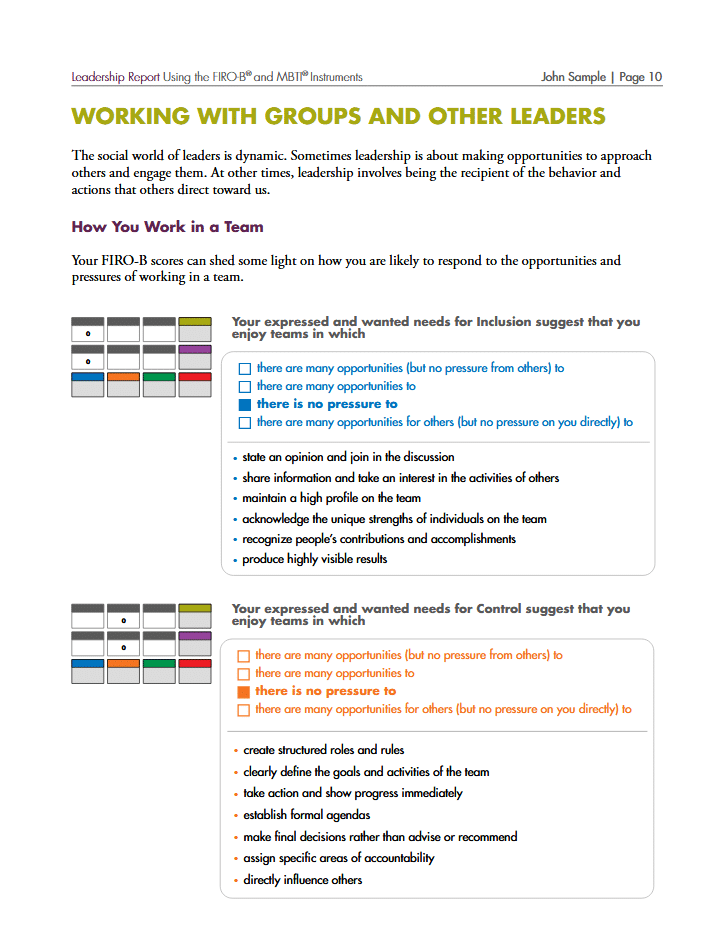E FIRO-B tool measures your interpersonal needs in three areas. For each of the three interpersonal needs Inclusion, Control, and A ection the FIRO-B instrument also provides a measure of how much each need is expressed or wanted by you. EXPRESSED e The extent to which you will initiate the behavior. Perceptual Learning Style Preference Questionnaire - Joy Reid (1984) The questionnaire is designed to assess individuals’ preferences for learning. It uses auditory, visual, and kinesthetic/tactile distinctions. It also tests for preferences for group work vs. Individual work. A 5-point scale is used, and major and minor preferences are.
Over fifty subjects completed four personality measures used in personnel selection. Based on a latin-square design they were asked to fill them in as they would if they were trying to present themselves as ideal candidates for the job of librarian, advertising executive or banker, while on one questionnaire they gave “honest,” actual responses. The results indicated, as previous research. Format and Content of FIRO-B When taking this questionnaire, you will find nine items per each of the six social needs highlighted. The 54 items are to be answered within 15 minutes. The initial 16 items are each followed by a rating scale of 1-6. Whare can I get FIRO B Questionnaire and scoring sheet? I want to know the names websites from where I can download the same free of cost 9th February 2010 From India, Pune. #Subject List: free of cost firo b City-India-Pune Country-India. Other Similar User Discussions On Cite.Co. Plz fill the questionnaire (request to every employee).
On-line & Off-line Survey Instruments:
Motivation, Cognitive Styles, Learning Styles,
and Learning Strategies
This collection is intended as a brief guide to the world of motivation, cognitive-style, learning-style, and learning-strategy questionnaires.
The first section of this bibliography is a list of websites which offers survey instruments related to motivation, learning preferences, and learning strategies. These consist of two kinds of sites:
interactive sites allow users to take the tests on-line and provide some information about the tests, however, they usually do not provide scoring algorithms.
source sites permit visitors to download and print ready-to-use tests. These sites vary as to the amount of information provided.
In the second section, a collection of instruments not available on the web is provided.
This bibliography is meant to provide teachers and researchers with a way to familiarize themselves with some of the instruments available. Users are warmly encouraged to seek more complete information about instruments before using them for research purposes and to observe copyrights in all instances.
-- Jeffrey A. Hatcher--
If you have suggestions or comments about the bibliography, please contact me at the following address: jhatcher@hawaii.edu
ON-LINESURVEY INSTRUMENTS
Personality Tests
The Keirsey Character Sorter
http://www.keirsey.com/cgi-bin/keirsey/kcs.cgi
The Keirsey Character Sorter classifies and describes people on the basis of types/temperament types. An individual’s temperament is seen as an innate predisposition which leads to the development of character. Individuals are classified as Rationals, Idealists, Artisans, or Guardians. Within these categories, distinctions are made using the following dimensions: extroversion-introversion, intuition-sensing, thinking-feeling, judgement-perception. The Keirsey test attempts to identify individuals’ 'skilled action roles' and produces the following system of classification:
Rational: Fieldmarshals, Masterminds, Inventors, Architects
Idealists: Teachers, Counselors, Champions, Healers
Artisans: Promoters, Crafters, Performers, Composers
Guardians: Supervisors, Inspectors, Providers, Protectors
Like the Myers-Briggs, the Keirsey test is based on Jung's theory of psychological types.
There are 16 items with four choices. Test-takers rank the choices in order. Responses are submitted and results returned.
For more information, go to: http://www.keirsey.com
The Keirsey Temperament Sorter II
http://www.keirsey.com/cgi-bin/keirsey/newkts.cgi
The Keirsey Character Sorter II uses the four temperament types: Guardian, Artisan, Idealist, and Rational. This test adds a measure to distinguish types of intelligence: tactical, logistical, diplomatic, and strategic. The test has 70 items. Respondents select one of two options. Detailed information about the various types is provided. Responses are submitted and results returned.
Fundamental Interpersonal Relations Orientation-Behavior (FIRO-B)
http://www.cl.uh.edu/edu/awl/survey/firo.html
A three-part, 54-item questionnaire which focuses on personal needs and behavior. It is typically used by companies to assess employee behavior. It provides insight into individual characteristics and compatibility. The test can be taken and submitted at this site. The scoring algorithm is not available.
A Personal Style Inventory
http://www.fln.vcu.edu/Intensive/PSI.html
This test is designed for college learning situations. It is based on a test developed by R. Craig Hogan and David W. Champagne which is based on the Myers-Briggs model. More information about the test is available in Supervisory and Management Skills: A Competency Based Training Program for Middle Managers of Educational Systems by Hogan & Champagne. There are 32 items with a 5-point scale. Responses are submitted and results returned. The site is not fully functioning at this time.
Extraversion/Introversion Inventory
http://www.psychtests.com/extraver.html
The test contains 27 items. In addition, there are 13 checkbox items at the end. Age and gender information are asked for but not required. Responses are submitted and scores returned with a brief interpretation.
Assertiveness Test
http://www.queendom.com/assert.html
This test consists of 32 items with a 5-point scale. Responses are submitted and scores returned with a brief interpretation.
Social Anxiety Test
http://www.queendom.com/soc_anx.html
This test consists of 25 items with a 5-point scale. Responses are submitted and scores returned with a brief interpretation.
Cognitive Style
Assessing Your Learning Style: An Inventory of Multiple Intelligences http://snow.utoronto.ca/Learn2/lstest.htm
This is a 70-item questionnaire which is based on Gardner's multiple intelligences theory. A 5-point Likert scale is used. Responses are submitted and numbers returned. The site promises to return an assessment of preferences, descriptions, and recommendations in the future.
The Cognitive Style Instrument
http://www.cl.uh.edu/edu/awl/survey/cogsi.html
The test posits eight situations and requires test-takers to make three choices in each situation. There are 24 items. A score is given for each of the following areas: Intuitive, Thinking, Sensing, and Feeling. Mean scores by gender are also provided.
Sternberg-Wagner Thinking Styles Inventory
http://snow.utoronto.ca/Learn2/tsscale.htm
The inventory focuses on thinking styles as revealed by approach to task completion. There are 104 items with a 7-point Likert scale. The site promises a link to brief interpretation page, but this is not currently available. An email address is required to take the inventory. To interpret the results, the site author recommends Robert Sternberg's Thinking Styles. At a later date, automated feedback with individualized descriptions may be available at the website.
Index Of Learning Styles (ILS)http://www2.ncsu.edu/unity/lockers/users/f/felder/public/ILSdir/ilsweb.html
The Index of Learning Styles is designed to assess preferred learning style along four dimensions: active/reflective, sensing/intuitive, visual/verbal, and sequential/global. The test is based on a learning style model developed by Richard M. Felder and Linda K. Silverman. It consists of 44 items. The test can be taken or a paper and pencil version downloaded at: http://www2.ncsu.edu/unity/lockers/users/f/felder/public/ILSdir/ILS-a.htm.
The scoring rubric is available at the following site: http://www2.ncsu.edu/unity/lockers/users/f/felder/public/ILSdir/ILS-b.htm
A four-page descriptive handout for score interpretation can be downloaded at: http://www2.ncsu.edu/unity/lockers/users/f/felder/public/ILSdir/styles.htm
The developers are interested in receiving data from people who use the test. For information, go to: http://www2.ncsu.edu/unity/lockers/users/f/felder/public/ILSpage.html
Firo-b Questionnaire Free Download
Learning Style Inventory http://www.hcc.hawaii.edu/intranet/committees/FacDevCom/guidebk/teachtip/lernstyl.htm
This test is adapted from Barsch Learning Style Inventory by Jeffrey Barsch, Ed.D.
and Sensory Modality Checklist by Nancy A. Haynie. It contains 24 items with a 3-point scale. It assesses individual’s auditory, visual, and tactile preferences in learning situations. Brief descriptions of the three types are provided with links to teaching tips.
Learning Modality Assessment Toolhttp://www.asd.k12.ak.us/Homepages/ROnorato/modality.html
This test is adapted from Incentive Publications Inc., Nashville, TN (1990). It contains 14 items with three choices (auditory, visual, and kinesthetic) for each item. Scores are computed based on the number of times each modality was chosen. A brief description of modalities is provided. The page is formatted for printing.
The Grasha-Riechmann Student Learning Style Scaleshttp://www.fln.vcu.edu/Intensive/GRLSS.html
This test is designed to assess differences in learning styles among late post-secondary and university students. It focuses on interactional habits. The full test has 90 items and a 5-point scale. This site currently lists 12 items and is not working at present.
Index of Learning Styles
http://www.crc4mse.org/ILS/self_test.html
The test contains 44 items, each with two choices. Responses are submitted and scores returned.
Personal Learning Style Inventory
http://www.howtolearn.com/personal.html
The site claims that the Learning Style Inventory is currently being used by hundreds of corporations including NASA, Blue Cross, Blue Shield, Motorola University, Bose, and Penn State University. They also claim that it is widely used by parents, teachers, and students around the world. The test has 36 items and checkboxes. Responses are submitted and results returned.
Tolerance of Ambiguity Scale
http://www.cl.uh.edu/edu/awl/survey/toler.html
The test consists of 16 items with a 7-point Likert scale. Responses are submitted and scores returned. Scores are broken down into three parts: Novelty, Insolubility, and Complexity.
Innovative Attitude Scale
http://www.cl.uh.edu/edu/orgbeh/orgpub/survey/ias.html

The test consists of 20-items with a 5-point Likert scale. It focuses on attitudes toward work situations (task and interpersonal).
Motivation
Canfield's Learning Styles Inventory
http://www.tecweb.org/eddevel/canfield1.html
This is a 30-item inventory which determines learning preferences. Each item has four choices which are ranked from 1 to 4 in terms of preference. Results are given for four categories: Conditions, Content, Mode, and Expectancy. Scores for each category can be interpreted in terms of the following criteria: Peer, Organization, Goal Setting, Competition, Instructor, Detail, Independence, Authority, Numeric, Qualitative, Inanimate, People, Listening, Reading, Iconic, Direct Experience, and Expectancy.
Locus of Control
http://www.psychtests.com/lc.html
This is a 42-item test with a 5-point scale. No information on scoring is provided. Responses are submitted and scores returned with a brief interpretation.
Locus of Control Scale
http://www.cl.uh.edu/edu/awl/survey/locus.html
This is a 29-item interactive questionnaire. For each item, there are two choices. The questionnaire is one in a collection of instruments available at the site. The website focuses on business skills development. No scoring information is provided. Responses are submitted and results returned.
Learning Strategies
Time Management
http://www.cl.uh.edu/edu/awl/survey/time.html
This questionnaire consists of two sections. The first is suitable for individuals in a variety of settings; the second is specifically for people in managerial positions. Each section consists of 20 items. A 5-point scale is used. No information about the instrument is provided, and responses must be submitted for scoring.
Learning and Teaching Style Assessment
Temporal & Spatial Learning Situation Preferenceshttp://www.fln.vcu.edu/Intensive/chronotope.html
This questionnaire is a 52-item survey which looks at the following categories: sleep and rising habits; concentration and work ability times; eating, drinking and munchies; temperature, comfort, and noise. Within in each category, preferences are checked. Responses are submitted and results returned.
Teaching Style Inventory(adapted from Dunn & Dunn, 1993) http://snow.utoronto.ca/Learn2/tchtest.htm
This test evaluates teachers as Individualized, Somewhat Individualized, Transitional, Somewhat Traditional, or Traditional based on responses to 67 items. The questionnaire is divided into six sections: Instructional Planning, Teaching Methods, Teaching Environment, Room Design, Evaluation Techniques, Teaching Characteristics, and Teaching Philosophy. A 5-point Likert scale is used. The scoring rubric is provided, and the page is formatted to be printed.
See http://www.quincy.edu/~mulrich/onlineinteractive.html for a number of other tests.
OFF-LINE SURVEY INSTRUMENTS

Personality
Myers-Briggs Type Indicator(MBTI)– Myers-Briggs (1975)
The Myers-Briggs test is based on Carl Jung’s psychological type theory. The MBTI identifies personality types based on four scales: extraversion-introversion, sensing-intuition, thinking-feeling, and judging-perceiving. This results in 16 different combinations or types.
For more information, go to:
http://www.mbti.com/text/orgmbtit.htmhttp://www.geocities.com/SiliconValley/Vista/8405/ddli.html
Fitzgerald, C., & Kirby, L. K. (1997). Developing Leaders: Research and Applications in Psychological Type and Leadership Development. Palo Alto, CA: Davies-Black Publishing.
Kolb Inventory– Kolb (1976, 1985)
This test assesses cognitive style based on preferences for learning modes: concrete experience (feeling), reflective observation (watching), abstract conceptualization (thinking), and active experimentation (doing). Students are classified as Divergers, Assimilators, Convergers, or Accommodators.
For more information, go to:

Kolb, D. A. (1976). Learning Styles Inventory. Boston: McBer and Company.
Kolb, D. A. (1984). Learning Style Inventory and Technical Manual. Boston: McBer and Company.
Reid, J. M. (1995). Learning Styles in the ESL/EFL Classroom, Boston, MA: Heinle & Heinle.

Foreign Language Classroom Anxiety Scale(FLCAS)- Horwitz (1985)
This test is designed to measure individuals’ anxiety in foreign language classroom situations. There are 33 items and a 5-point scoring scale. A description of the test can be found in Horwitz, E. K. (1986). Foreign language classroom anxiety, Modern Language Journal, 70, 125-136.
Hartmann Boundary Questionnaire (HBQ) – Hartmann (1991)
The test examines individuals’ separation of internal, interpersonal, and external experiences. The test contains 146 items.
For more information, see the following:
Ehrman, M. (1998). MLAT for predicting success and advising students, Applied Language Learning, 9, 31-70.
Second Language Tolerance of Ambiguity Scale – Christopher M. Ely
The test is designed to assess students’ tolerance of uncertainty, incomplete understanding, and inability to express themselves fully in English. The test consists of 12 items with a 4-point scale. Scores for all items are totaled and then placed on a scale between 12 and 48. A sample of the test with scoring scale is provided in Reid, J. M. (1995). Learning Styles in the ESL/EFL Classroom, Boston, MA: Heinle & Heinle.
For permission to use the scale, contact Christopher Ely, Department of English, College of Sciences and Humanities, Ball State University, Muncie, IN 47306-0460 or call (317) 285-8580.
Perceptual Learning Preference Survey – Kinsella (1993)
This is a 32-item test which identifies learner cognitive style preferences. A 3-point scale is used. The test and descriptive information is provided in Reid, J. M. (1995). Learning Styles in the ESL/EFL Classroom, Boston, MA: Heinle & Heinle.

For permission to use the survey, contact Kate Kinsella, Multifunctional Resource Center/Northern California, 1212 Broadway Street, Suit 400, Oakland, CA 94612.
Aptitude
Modern Language Aptitude Test (MLAT) – Carroll & Sapon (1959)
The MLAT is a 165-item language aptitude test developed in 1959. The test was developed for adults and high school students. It is divided into five parts: Number Learning, Phonetic Script, Spelling Clues, Words in Sentences, and Paired Associates.
Carroll, J. B., & Sapon, S. M. (1959). Modern Language Aptitude Test: MLAT Manual. New York: The Psychological Corporation.
Pimsleur Language Aptitude Battery - (PLAB) Pimsleur (1965)
The (PLAB) was developed for students in grades 7 to 12.
For more information, see the following:
Pimsleur, P. (1966). Pimsleur Language Aptitude Battery. Harcourt, Brace & World.
Motivation
Attitude/Motivation Test Battery (AMTB)– Gardner (1985)
This is a large battery of tests which measures a number of different aspects of language learning. The instrument was originally used to measure attitudes of students studying English and French in Canada. Scales included attitudes toward French Canadians, interest in foreign languages, attitudes toward European French people, attitudes toward learning French, integrative orientation, instrumental orientation, anxiety, parental encouragement, motivational intensity, and desire to learn French. The scale instrument has been modified more recently.
For more information, see the following sources:
Gardner, R. C. (1985). Social Psychology and Second Language Learning: The Role of Attitudes and Motivation. London: Edward Arnold.
Tremblay, P. F., & Gardner, R. C. (1995). Expanding the motivation construct in language learning, Modern Language Journal, 79, 505-518.
Experience Sampling Method Questionnaire
This instrument contains 35 items. Informants fill out the questionnaire whenever they receive an electronic signal. The purpose is to capture attitudes, feelings, and details about level of engagement on task without relying on recall. The instrument was used by Schmidt & Savage (1992) and was adapted from Csikszentmihalyi & Larson (1987).
For more information, see the following sources:
Schmidt, R., & Savage, W. (1992). Challenge, Skill, and Motivation, PASAA, 22, 14-28.
Csikzentmihalyi, M., & Larson, R. (1987). Validity and reliability of the experience-sampling method. The Journal of Nervous and Mental Diseases, 175, 526-536.
Schmidt et al.’s Motivation, Learning Preferences, and Strategy Use Questionnaire
Schmidt, Boraie, and Kassabgy (1996) conducted an exploration of motivation, learning preferences, and strategy use among an Egyptian EFL population. The questionnaire is in three parts. The Motivation section contains 50 items which focus on the following components: intrinsic, extrinsic, personal goals, expectancy/control, attitudes, anxiety, and motivational strength. The Learning Preferences section has 22 items, and the Learning Strategies section has 25 items. A 6-point Likert scale was used.
For more information, see the following:
Schmidt, R., Boraie, D., and Kassabgy, O. (1996). Foreign language motivation: Internal structure and external connections. In R. Oxford (Ed.), Language Learning Motivation: Pathways to the New Century. (Technical Report #11), 9-70. Honolulu: University of Hawai’i, Second Language Teaching & Curriculum Center.
Affective Survey – Ehrmann and Oxford (1991)
This questionnaire contains 114 items and is divided into three sections: motivation, beliefs self, and anxiety. The scale draws upon the work of Gardner (1985b), Campbell (1987), Horwitz (1985), and Horwitz (1986). The instrument is unpublished at this time.
For more information, go to:
www.lll.hawaii.edu/nflrc/si99/strategylist.htm
Strategies
Motivated Strategies for Learning Questionnaire (MSLQ)– Pintrich et al (1989)
Designed at the National Center for Research to Improve Postsecondary Teaching and Learning (NCPIPTAL), this instrument has 85 items with a 7-point scale. There are two sections, a motivation section and a learning strategies section. Scores for subscales are derived by averaging scores within the subscales.
For more information, see the following sources:
Pintrich et al. (1989). A Manual for the Use of the Motivated Strategies for Learning Questionnaire (MSLQ), National Center for Research to Improve Postsecondary Teaching and Learning (NCRIPTAL), School of Education, The University of Michigan, Ann Arbor, Michigan.
Pintrich, P, R. and Johnson, G. R. (1990).Assessing and improving students' learning strategies. New Directions for Teaching and Learning (The Changing Face of College Teaching), 42, 83-92.
Learning Preferences
The Learning Channel Preference Checklist– Lynn O’Brien (1990)
This instrument determines learners’ preferred modes of learning. Students are classified as Visual, Auditory, or Haptic (kinesthetic/tactile). This test consists of 36 items with a 5-point scale. A sample of the test with scoring scale is provided in Reid, J. M. (1995). Learning Styles in the ESL/EFL Classroom, Boston, MA: Heinle & Heinle.
For permission to use the survey, contact Specific Diagnostic Studies, 1160 Nebel Street, Suite 130, Rockville, MD 20852.
The National Association of Secondary Schools Principals’ Learning Style Profile (LSP)
Free Firo B Questionnaire Pdf
The NASSP test consists of 125 items. The test assesses Cognitive Skills, Perceptual Preferences, Study Preferences, and Instructional Preferences. It is available in English and Spanish.
For more information, go to: http://www.nassp.org/publications/learnstyles/index.html
Perceptual Learning Style Preference Questionnaire- Joy Reid (1984)
The questionnaire is designed to assess individuals’ preferences for learning. It uses auditory, visual, and kinesthetic/tactile distinctions. It also tests for preferences for group work vs. individual work. A 5-point scale is used, and major and minor preferences are identified. A sample of the test with scoring scale is provided in Reid, J. M. (1995). Learning Styles in the ESL/EFL Classroom, Boston, MA: Heinle & Heinle.
For permission to use the questionnaire, contact Joy Reid, Department of English, University of Wyoming, Laramie, WY 82070.
Style Analysis Survey (SAS) – Oxford (1993)
This is a five-part instrument for self-assessment of learning preferences. There are 110 items on a 4-point scale. A sample of the test with scoring scale is provided in Reid, J. M. (1995). Learning Styles in the ESL/EFL Classroom, Boston, MA: Heinle & Heinle.
For permission to use the questionnaire, contact Rebecca L. Oxford, Department of Curriculum, University of Alabama, Tuscaloosa, AL 35487.